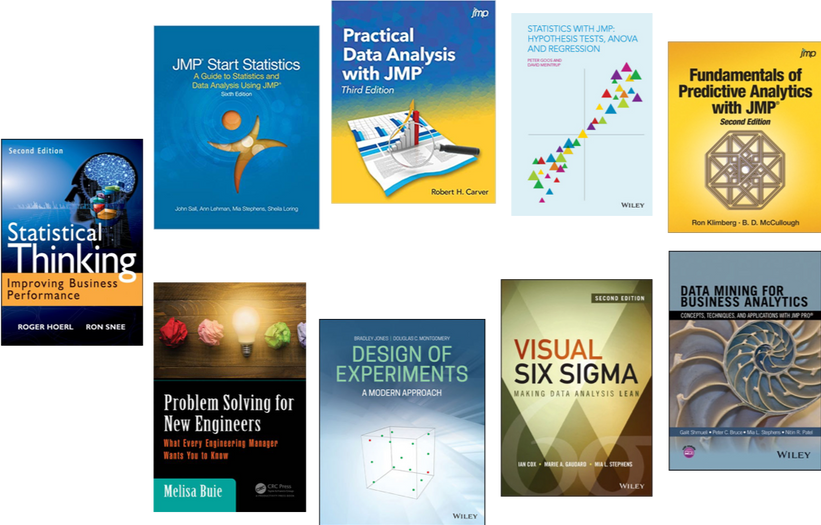- JMP will suspend normal business operations for our Winter Holiday beginning on Wednesday, Dec. 24, 2025, at 5:00 p.m. ET (2:00 p.m. ET for JMP Accounts Receivable).
Regular business hours will resume at 9:00 a.m. EST on Friday, Jan. 2, 2026. - We’re retiring the File Exchange at the end of this year. The JMP Marketplace is now your destination for add-ins and extensions.
JMP Blog
A blog for anyone curious about data visualization, design of experiments, statistics, predictive modeling, and more- JMP User Community
- :
- Blogs
- :
- JMP Blog
- :
- The bread and butter when teaching with JMP: Self-paced learning and practice (4...
- Subscribe to RSS Feed
- Mark as New
- Mark as Read
- Bookmark
- Subscribe
- Printer Friendly Page
- Report Inappropriate Content

Courses with such online or virtual elements are typically structured and managed using Learning Management Systems like Blackboard or MOODLE. JMP has many educational offerings that fit nicely into these state-of-the-art teaching environments.
STIPS and SKP
What is it? These two online resources have some roots in the JMP Academic Program, but were developed by other JMP groups.
The online course “Statistical Thinking for Industrial Problem Solving” (aka STIPS) has seven modules, totaling about 30 hours of self-paced learning. Each module includes short instructional videos, JMP demonstrations, questions and exercises. Exercises can be done using a browser to access JMP Pro in the cloud or using JMP Pro locally after downloading the data sets. All modules and their topics covered are outlined here.

STIPS was driven by two demands: First, the goal was to teach the most relevant analytical skills to solve real-world problems, as collected from our industrial customers through a huge survey. They were prioritized and structured to design the seven STIPS modules. Second, an increasing need for certification – in industry and academia – led to exams on two levels: If you pass the online exams at the end of each module, you earn an electronic badge. After you pass the whole STIPS program, you can take a performance-based examination called “JMP Certified Associate: Statistical Thinking for Industrial Problem Solving”.
The Statistics Knowledge Portal, or SKP (pronounced “skip”), is an online course that uniquely combines concise explanations with illuminating examples and graphics to help learners establish a firm foundation upon which to build statistical skills.
Where to find? Both resources are free to anyone interested in building practical skills in using data to solve problems better: You can enroll for STIPS at www.JMP.com/statisticalthinking. Your profile is used to track your progress and assign badges. The SKP home page is available www.jmp.com/skp.
How to use? STIPS modules can support your curricula in many ways: Before coming into class, students can take select modules to align pre-knowledge (for example, suggest the “Correlation and Regression” module to recap basic knowledge in statistics). During class, STIPS modules can be used as assignments, with optional tracking by badge. After a class, students can learn about other relevant topics that are not included in the standard curriculum. Most important, all modules help students to become better problem solvers in their future workplaces (and show their badges on applications).
SKP is suggested as a less technical introduction to basic statistical concepts. These motivating and memorable lessons underline the importance of statistical methods and should inspire the student to learn more.
E-learning courses
What is it? One way to learn more are the self-paced e-courses from SAS. Each e-course produces a certificate of completion and is freely available to all faculty members and students covered by an Academic Suite annual site license.

The courses need up to 16 hours of e-learning and cover, for instance, an introduction to statistics (ANOVA and Regression), classic and custom DOE. They require a local JMP installation for practice. The content is equivalent to the trainer kits.
Where to find? The e-courses can be found on the JMP resources portal > Course Material Library > Online Courses Using JMP > eCourses from SAS Education.
How to use? These in-depth courses can be used to learn more after passing a STIPS module. The ANOVA and Regression course provides a solid foundation about statistical concepts, for example, for students who missed such a course for any reason. The two DOE courses are highly recommended and a unique offering to acquire skills that are in increasing demand by industry and insufficiently taught in curricula today.
Webinars
What is it? Most JMP webinars are an hour long and offered either as live sessions on a regular basis or as webinars on-demand. All webinars focus on demonstrations and best practices of academic use of JMP software and resources.
Where to find? Both the Live Academic Webinars and the Academic Webinar Library (on-demand) can be found on the resources portal at http://www.jmp.com/teach. Some webinars are offered in other languages than English, please check your regional JMP web site. More on-demand webinars organized by JMP Marketing or Customer Care, including the popular series Analytically Speaking (interviews with thought-leaders) and Mastering JMP (online seminars for JMP users) can be found here.
How to use? The typical usage of a webinar is on-demand, either as an introduction (Getting Started, Basics for Professors and Students) or to learn about a specific topic of interest. Many webinars offer a JMP journal and dataset(s) for download.
Books
What is it? Numerous books and textbooks integrating JMP are available from SAS Press and other publishers.
Where to find? A book listing showing some of the books integrating JMP can be found on the JMP academic resources portal > Books with JMP. If you have information about other books published using JMP, please contact the JMP academic team so we can add the new books to the list.
Review copies of books from SAS Press are available in PDF format for instructors considering course adoption. For a free academic evaluation copy of a SAS book please visit the Academic Evaluation Copy Request Form.

A PDF version of Sall, Stephens, Lehman and Loring: JMP Start Statistics (2nd Edition 2017) is also available for download to everybody who enrolled to the STIPS online course.
How to use? Many textbooks are designed for course use or as a supplementary resource and offer datasets and teaching material for download.
In my next post, we have a look at more resources to teach real-world problem solving.
Click to see the other posts in this series about teaching with JMP.
- © 2026 JMP Statistical Discovery LLC. All Rights Reserved.
- Terms of Use
- Privacy Statement
- Contact Us

You must be a registered user to add a comment. If you've already registered, sign in. Otherwise, register and sign in.